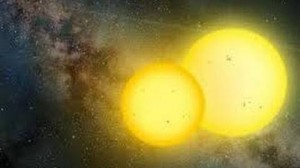Scientists Discovered Sibling of Sun 110 Light Years away
Wednesday, May 14th, 2014 6:52:19 by Shakira Subhani
A star located about 110 light-years away from Earth in the constellation of Hercules, has been identified by an international team of astronomers as ” the first brother of the Sun ” found. Both stars must have formed in the same cloud of gas and dust just over 4,500 million years ago. “We know where we were born,” says Ivan Ramirez, a scientist at the University of Texas at Austin and team leader. “If we can figure out where in the galaxy the Sun formed, we can narrow the conditions of the early solar system and that would help us understand why we are here.”
The star in question, called HD 162826, is 15% more massive than the Sun and not visible to the naked eye in the sky, although it is easy to find with binoculars looking near the star Vega. Around it does not have any giant planet orbiting Jupiter type, but the researchers, who presented their work in The Astrophysical Journal, do not rule out smaller planets may have. As for the distance that is, 110 light years from Earth, we should remember that the nearest star, Proxima Centauri, is 4.2 light years.
The Sun, HD 162826, and thousands more stars formed by gravitational effects in a cloud of gas and dust in the galaxy, but the objects are formed and now may be dispersed in different parts of the Milky Way, says Ramirez. “Some stars, such as HD 162826, are still in the vicinity of the sun, others will be much further,” he adds.
Researchers have tracked thirty stars identified by various scientific groups as candidates for the Sun family Specifically, Ramirez ‘s team studied 23 of these stars with the Harlan J. Smith Telescope at McDonald Observatory (University of Texas) and the other seven, visible from the southern hemisphere, with the Magellan Clay telescope in Las Campanas observatory (Chile). The spectroscopic analysis of the light from these stars has identified the key chemical features. In addition, astronomers have investigated the orbital dynamics of these stars for their movements, and that two specialists team have been busy at HV Bajkova, Pulkovo observatory in St. Petersburg (Russia) and VVBobylev, State University of St. Petersburg. Combining the information from these two lines of work has converged on the identification of HD 162826 as Sister Sol.
Ramirez work can advances leading to tracing more stars in similar family. In addition, the researcher points out in a statement of the University of Texas, there is a “small, but not zero” probability that the stars sisters can have planets that harbor life.
Short URL: https://www.newspakistan.pk/?p=44008

















